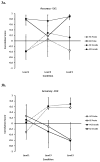Working memory circuitry in schizophrenia shows widespread cortical inefficiency and compensation
- PMID: 20096539
- PMCID: PMC2821986
- DOI: 10.1016/j.schres.2009.12.014
Working memory circuitry in schizophrenia shows widespread cortical inefficiency and compensation
Abstract
Background: Working memory studies in schizophrenia (SZ), using functional magnetic resonance imaging (fMRI) and univariate analyses, have led to observations of hypo- or hyperactivation of discrete cortical regions and subsequent interpretations (e.g. neural inefficiencies). We employed a data-driven, multivariate analysis to identify the patterns of brain-behavior relationships in SZ during working memory.
Methods: fMRI scans were collected from 13 SZ and 18 healthy control (HC) participants performing a modified Sternberg item recognition paradigm with three memory loads. We applied partial least squares analysis (PLS) to assess brain activation during the task both alone and with behavioral measures (accuracy and response time, RT) as covariates.
Results: While the HC primary pattern was not affected by increasing load demands, SZ participants showed an exaggerated change in the Blood Oxygenation Level Dependent (BOLD) signal from the low to moderate memory load conditions and subsequent decrease in the greatest memory load, in frontal, motor, parietal and subcortical areas. With behavioral covariates, the separate groups identified distinct brain-behavior relationships and circuits. Increased activation of the middle temporal gyrus was associated with greater accuracy and faster RT only in SZ.
Conclusions: The inverted U-shaped curves in the SZ BOLD signal in the same areas that show flat activation in the HC data indicate widespread neural inefficiency in working memory in SZ. While both groups performed the task with similar levels of accuracy, participants with schizophrenia show a compensatory network of different sub-regions of the prefrontal cortex, parietal lobule, and the temporal gyri in this working memory task.
(c) 2009 Elsevier B.V. All rights reserved.
Conflict of interest statement
None of the authors had any conflict of interest.
Figures




Similar articles
-
Effects of treatment with the atypical neuroleptic quetiapine on working memory function: a functional MRI follow-up investigation.Eur Arch Psychiatry Clin Neurosci. 2006 Dec;256(8):522-31. doi: 10.1007/s00406-006-0687-x. Epub 2006 Dec 6. Eur Arch Psychiatry Clin Neurosci. 2006. PMID: 17151834
-
Working memory and DLPFC inefficiency in schizophrenia: the FBIRN study.Schizophr Bull. 2009 Jan;35(1):19-31. doi: 10.1093/schbul/sbn162. Epub 2008 Nov 27. Schizophr Bull. 2009. PMID: 19042912 Free PMC article.
-
Task-related fronto-striatal functional connectivity during working memory performance in schizophrenia.Schizophr Res. 2013 Nov;150(2-3):468-75. doi: 10.1016/j.schres.2013.08.009. Epub 2013 Sep 7. Schizophr Res. 2013. PMID: 24016726
-
Shared and distinct brain fMRI response during performance of working memory tasks in adult patients with schizophrenia and major depressive disorder.Hum Brain Mapp. 2021 Nov;42(16):5458-5476. doi: 10.1002/hbm.25618. Epub 2021 Aug 25. Hum Brain Mapp. 2021. PMID: 34431584 Free PMC article. Review.
-
Memory and cognition in schizophrenia.Mol Psychiatry. 2019 May;24(5):633-642. doi: 10.1038/s41380-018-0231-1. Epub 2018 Sep 21. Mol Psychiatry. 2019. PMID: 30242229 Free PMC article. Review.
Cited by
-
Functional imaging of the hemodynamic sensory gating response in schizophrenia.Hum Brain Mapp. 2013 Sep;34(9):2302-12. doi: 10.1002/hbm.22065. Epub 2012 Mar 28. Hum Brain Mapp. 2013. PMID: 22461278 Free PMC article.
-
The Visual Word Form Area compensates for auditory working memory dysfunction in schizophrenia.Sci Rep. 2020 Jun 1;10(1):8881. doi: 10.1038/s41598-020-63962-0. Sci Rep. 2020. PMID: 32483253 Free PMC article. Clinical Trial.
-
Functional Connectivity During Visuospatial Processing in Schizophrenia: A Classification Study Using Lasso Regression.Neuropsychiatr Dis Treat. 2021 Apr 14;17:1077-1087. doi: 10.2147/NDT.S304434. eCollection 2021. Neuropsychiatr Dis Treat. 2021. PMID: 33888984 Free PMC article.
-
Altered cortical thickness related to clinical severity but not the untreated disease duration in schizophrenia.Schizophr Bull. 2015 Jan;41(1):201-10. doi: 10.1093/schbul/sbt177. Epub 2013 Dec 18. Schizophr Bull. 2015. PMID: 24353097 Free PMC article.
-
Connectomic Underpinnings of Working Memory Deficits in Schizophrenia: Evidence From a replication fMRI study.Schizophr Bull. 2020 Jul 8;46(4):916-926. doi: 10.1093/schbul/sbz137. Schizophr Bull. 2020. PMID: 32016430 Free PMC article.
References
-
- Andreasen NC. Modified Scale for the Assessment of Negative Symptoms (SANS) University of Iowa; Iowa City, IA: 1984a.
-
- Andreasen NC. Scale for the Assessment of Positive Symptoms (SAPS) University of Iowa; Iowa City, IA: 1984b.
-
- Barch DM, Sheline YI, Csernansky JG, Snyder AZ. Working memory and prefrontal cortex dysfunction: specificity to schizophrenia compared with major depression. Biological psychiatry. 2003;53(5):376–384. - PubMed
-
- Braver TS, Cohen JD, Nystrom LE, Jonides J, Smith EE, et al. A parametric study of prefrontal cortex involvement in human working memory. NeuroImage. 1997;5(1):49–62. - PubMed
Publication types
MeSH terms
Grants and funding
LinkOut - more resources
Full Text Sources
Medical

